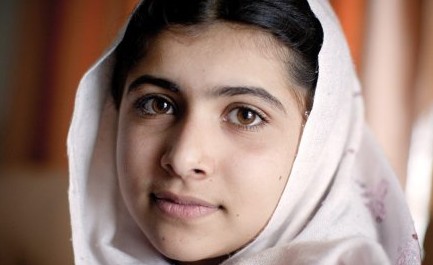Karachi is a city full of headlines: headlines describing murder and mayhem on the roads, headlines describing squabbles between political parties. There is no shortage of events in the country that generate ‘’breaking news”. I have to sadly admit that to some extent, I have become desensitized to these headlines.
However, when I saw the news flashes describing the shooting of a 15 year old girl activist by the Taliban, I sat up and took notice. It was not only the girl’s innocent face, that caught my attention, but also the reason she was shot. She was punished for daring to fight for education for young girls in Swat, an area with considerable Taliban influence. As I heard more details, the disparity of size and strength between an armed Taliban warrior (who may have shot her) and this petite, pretty girl became more evident and I wanted to cringe. What a price to pay for only wanting to read and write.
During the next few days, I discovered that there many Pakistanis who have not been desensitized to morbid headlines. There was a national outpouring of grief and rage against this act of violence. The media supported her cause, and slowly the tsunami of support became international. For many of us, a little girl, even though an activist, was too young to be taking a nation’s burdens upon herself and fighting for all our cause: education, progress, accountability. Her efforts to be heard, at the cost of her own life and safety, struck a chord in many people’s hearts. Malala had been warned, but continued to advocate for female literacy, through the BBC and other media channels, until she was shot.
Malala’s struggle, although focused on the education of girls, hides a deeper problem: the systematic and historic discrimination against women at many levels in Pakistan. In homes, where young girls are given secondary access to education, nutrition, attention and healthcare (particularly compared to young boys) and told that their role is that of submission and home-maker. In the workplace, where women often silently suffer bias or harassment, in order to succeed. After marriage, where they are often mistreated by in- laws and expected to contribute to household or even field chores. Particularly in rural areas, women are treated as commodities and suffer repeated pregnancies and ill health.
The evidence of this lack of rights is beginning to mount. In terms of socio-economic and health indicators, Pakistan fares little better than Afghanistan. The literacy rate for women in Pakistan is 42%, compared to 67% for men. The difference between urban and rural indicators is marked. In rural parts of Pakistan, female literacy falls to 30%. The maternal mortality rate for women is 276 per 100,000 births – one of the highest in Asia. The children are affected too, and infant mortality is 78 per 1000 births. Studies reveal that the link between the education of women, and their mortality and well-being is undeniable. Educated women have fewer children, live longer and are better able to cope with health-related problems for themselves and their families.
It is these statistics that make Malala’s struggle even more admirable. She was not from a particularly wealthy background. She was living in Swat, a relatively isolated region plagued by political turmoil – and increasing discrimination against women. All she had in her favor was her conviction (and that of her family) that things should be different.
Malala’s fate reminded me a little of that of Benazir. However Benazir was not as lucky as Malala, who made it out of the country, on the wings of an entire nation’s prayers. She was taken for medical treatment to London. Malala lived, and one of the first things she did when she regained consciousness, was to write about her condition and thank her supporters. “Malala will rise again”, was the statement issued by her father Ziauddin Yousufzai, also an activist for female literacy. “The pen is mightier than the sword”, came to my mind, as I saw her recover.
Who knows what Malala’s future will be? At a personal level, she is no longer in Swat and at least temporarily safe from her persecutors. In terms of her cause, Malala has become the voice and face of young girls around the world. On 10th December 2012, UNESCO and Pakistan jointly organized a conference in Paris to support the education of women. The title of the conference was “Stand Up for Malala – Stand Up for Girl’s Right for Education”. The Pakistan government has pledged to work with international agencies toward improving education for young girls. United Nation’s special envoy for global education and former British Prime Minister Gordon Brown,Gordon Brown announced appointment of Malala’s father Ziauddin Yousafzai, as special UN advisor on global education. Malala will be actively involved in her father’s work, at a global level.
Malala was also the runner up for the position of Time Magazine’s “Person of the Year 2012”.
Many may question such plans and projects… However, when I think of her story, I think: Go girl!
Although headlines regarding Malala may gradually be lost among the turbulent tides of Pakistani and world affairs, for many of us in Pakistan, we will remember the 15 year old girl who had the courage and confidence to take a stand for her beliefs. Beliefs that went beyond herself and her well-being. In this she was an inspiration – and rebuke – for many. Malala – the Pakistani girl, who proved she could.






